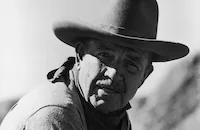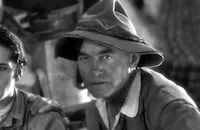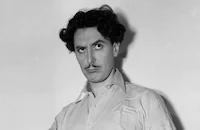Sundown
Brief Synopsis
Cast & Crew
Henry Hathaway
Gene Tierney
Bruce Cabot
George Sanders
Harry Carey
Joseph Calleia
Film Details
Technical Specs

Synopsis
At Manieka, an isolated outpost in British East Africa, civil commissioner William Crawford sends a telegram to the governor of Nairobi, requesting a furlough so that he may study the native customs of the Shenzi tribesman. Lieutenant Roddy Turner, concerned about rumors of impending trouble from the Shenzi, sends his own telegram urging the governor to deny Crawford's request. The governor responds by transferring control of the outpost to Major A. L. Coombes, who criticizes Crawford's lax security, particularly the fact that an Italian prisoner of war, Pallini, is permitted to cook for the officers. As Coombes is warning Crawford and Turner that the Shenzi have been arming themselves, they are joined by Dutch mineralogist Jan Kuypens, who had been acting for the Italian government and now offers his services to the British. Later, the native troops are ambushed by the Shenzi during a marching exercise, and Pallini warns Crawford and Coombes that Africa now has tremendous geopolitical significance, and that if Britain loses Africa, it will lose the war. Soon after, the exotically dressed Zia and her caravan approach the fort, and Pallini recognizes her as the operator of the largest trading network in Africa. That night, a birthday party for Pallini comes to an abrupt end when Zia and the natives suddenly leave, responding to a mysterious telepathic message that one of the white men will die. Crawford attributes this to Abdi Hammud, a suspected arms trader he had captured and released after the earlier ambush. The men keep careful watch, and when Hammud opens fire on the post with a machine gun, wounding Zia, who has returned to warn Crawford, they return fire and kill him. The next day, after Coombes has ordered her to leave the post, Zia tells Kuypens that she knows Hammud was distributing guns for him and offers to take over Hammud's smuggling route. As her caravan prepares to depart, Zia tells Pallini to warn Crawford about Kuypens, but Kuypens kills him before he can deliver his message. Crawford and Coombes, now in receipt of an official telegram identifying Kuypens as an arms dealer, set out in pursuit, stopping only to blow up a cache of guns at a native encampment. The next day, Crawford is captured and imprisoned in the fortress that serves as Kuypens' base of operations. As Kuypens communicates by radio with the Nazis, Zia warns Crawford that a series of native uprisings will begin the next day, and helps him escape from his cell. Kuypens catches Zia and tells her to order her caravan to release their arms to the Shenzi. She refuses, however, and fierce fighting breaks out among Kuypens' men and Zia's. Coombes, who had disguised himself as a member of the caravan, exchanges gunfire with Kuypens, and both men are killed. Later, at a bomb-ravaged church in London, newlyweds Crawford and Zia listen as the bishop, Coombes's father, repeats his son's final words, an inspirational message about the victory that will be England's.

Director

Henry Hathaway
Cast

Gene Tierney

Bruce Cabot

George Sanders

Harry Carey

Joseph Calleia

Reginald Gardiner

Carl Esmond
Marc Lawrence

Sir Cedric Hardwicke

Gilbert Emery
Jeni Le Gon
Emmett Smith

Dorothy Dandridge
St. Luke's Choristers
Horace Walker
Eddie Das
Prince Modupe
Hassan Said
Wesley Gale
Jester Hairston
Curtis Nero
Al Duval
Kenny Washington

Woodrow W. Strode
Walter Knox
William Broadus
Ivan Browning
William Dunn
Tetsu Komai
Frederick Clarke
Darby Jones
Blue Washington
Laurence La Marr
Frank Clark
George Lincoln
Martin Wilkins
Floyd Shackelford
Andrew Taylor
Crew
R. O. Binger
Charles G. Booth
Alexander Golitzen
Richard Irvine
Arthur A. Jacobson
Charles Lang
Fred Lau
Barré Lyndon
Barré Lyndon
Prince Modupe
Cliff Morgan
Jack Moss
Walter Plunkett
Miklos Rozsa
Hassan Said
Dorothy Spencer
Carl Voss
Walter Wanger
Ern Westmore
Lee Zavitz

Photo Collections
Videos
Movie Clip


Film Details
Technical Specs

Award Nominations
Best Art Direction
Best Cinematography
Best Score
Articles
Sundown (1941)
After establishing the Kenya region of British East Africa, Sundown kicks off with some very arresting imagery, as the exotically beautiful Zia (Gene Tierney) is set down by a prop airplane on the plains, has her shoes changed to a pair both regal and practical for walking, and immediately leads a large caravan into the mountains. With no further explanation, the scene shifts to Manieka, where a British outpost is manned by Civil Commissioner William Crawford (Bruce Cabot) and Lt. Roddy Turner (Reginald Gardiner). The lackadaisical operation of the base is summed up by Roddy's admission over drinks: "Best part of the day, sundown. Nothing more to do in a place where there's nothing to do anyway." This all changes when the Governor in Nairobi sends Major A. L. Coombes (George Sanders) to take over the base and respond to rumors that the nearby Shenzi tribesmen are being armed by Nazi forces. (Nazis and German forces are implied, but never named, in the film since the United States was not yet in the War). Coombes, who has brought crates of guns and gas masks with him, tightens up security at the base, and that includes putting Italian prisoner Pallini (Joseph Calleia) in lockup. The group is joined by a Dutch mineralogist (Carl Esmond) and a white hunter (Harry Carey), as well as Zia, a half-caste trader with strong ties to the people of Manieka. When the well-armed Shenzi attack the base, Zia assists the British in finding the source of the deadly munitions.
Producer Wanger assembled an impressive cast for Sundown; the 21-year-old Tierney was on loan-out from 20th-Century Fox on the condition that she was given top billing in all advertising. To direct, Wanger borrowed Henry Hathaway from Paramount Pictures; the versatile director was adept at many genres, including adventure, having helmed the previous hit The Lives of a Bengal Lancer (1935). Barre Lyndon wrote the screenplay from his novel, which had been successfully serialized in The Saturday Evening Post early in 1941. The eastern deserts of Africa were recreated via location shooting in Hollywood's oft-used Bronson Caverns, California's Mojave Desert, and, at Hathaway's suggestion, the high desert plains in the Ship Rock area of New Mexico, site of ancient Pueblo settlements.
Gene Tierney was not thrilled to be going off to New Mexico for three weeks of location shooting; she was a new bride, having married fashion designer Oleg Cassini two weeks prior. In her 1980 autobiography Self-Portrait, Tierney wrote, "The film was shot at a place called Ship Rock Hill, a New Mexico landmark. Twice a day we had to climb a steep slope to reach the set, an Arab village the crew had constructed....We were almost like a little city sprung up overnight, living at the foot of the hill in barracks that were temporary." Tierney describes the loneliness of being away from her new husband, as well as the difficult conditions. "I could barely bear the stifling heat and the stench of the camels. One of them tried to take a nip out of my derriere as I walked along in a dusty caravan."
Much of the advance publicity for Sundown focused on the exotic and revealing costumes designed for Tierney to wear. (Tierney appeared on the cover of no less than LIFE Magazine (the November 10, 1941 issue), standing in the New Mexico location sporting one of the less-revealing costumes). According to Tierney, a bit of the design work was done by the producer himself. "[My costumes] were veiled and scanty, but not quite daring enough to suit Walter Wanger. At the fittings one day he asked for a pair of scissors. Then he proceeded to cut out an opening in front, at the waist, and another in the back. I ended up having a low-slung skirt with my navel exposed and a bra with black and gold threads, a kind of harem girl costume. Walter stepped back, admired his handiwork, and said, 'There. Now you look right for the part.'"
Tierney also relates a story about co-star Bruce Cabot. "Lonely and miserable" during the shoot, Tierney only looked forward to twice-weekly drives into the nearest town courtesy of Cabot, where she was able to call her husband on the telephone. "Those trips were an adventure," she wrote. "Bruce kept a gun between us on the seat. The first night, after a few miles of nervous silence, I confessed that the gun frightened me. 'Good Lord, Bruce,' I said. 'Isn't it dangerous? Who, or what, do you expect to shoot?' 'Oh,' he said, 'I like to pop off a few coyotes on the way. I'm a huntsman.'"
Sundown is particularly notable for the sumptuous black-and-white cinematography of Charles Lang. The film's remarkable shots shift from loving sunlit close-ups of Tierney's beauty to stark nighttime gun battles illuminated by violent flashes and streaks of tracer bullets. Hathaway discussed Lang in interviews conducted by Polly Platt for the American Film Institute in 1973; Hathaway noted that Lang worked very slowly: "We got eight or nine shots a day, that's all we ever got. And it took him longer to light a close-up than a long shot. I used to get so mad at Charlie once in a while. ...He'd come in in the morning and he's got on his over coat and these tweed jackets and a muffler and one of those cloth-like hats, folded down, and he starts to look and he'd say, 'Well, I didn't want that light there. Now take all that stuff off of that backing, dammit, Henry,' Henry was his gaffer. 'I told you not to start and rough in the set without getting me; now take them all away. Now put one over here.' By 10:30, he's still got the overcoat on, the muffler's still on, the sweat is running off him, he doesn't even know he's got them on. I said, 'Charlie, take your overcoat off.'"
Sundown works most effectively as an adventure tale, but falters in its moments of patriotic and religious fervor. As Matthew Bernstein wrote in Walter Wanger, Hollywood Independent, "...[Wanger] insisted that his screenwriters tag on an epilogue in the manner of Foreign Correspondent. Here, Sanders ...speaks about the glories of the English church and the British army, spilling out a stream of consciousness confession that seems totally absurd after his tight-lipped demeanor throughout the film." Bernstein also noted, "...Wanger ensured that the anti-fascist African characters (including those played by Woody Strode and Dorothy Dandridge) were given more progressive and rounder characterizations than was common in Hollywood films of the period." (Wanger felt very strongly that African-Americans deserved better roles in Hollywood; as Bernstein relates, "after the release of Sundown, he in mid-1942 cosponsored [with Darryl Zanuck and 1940 presidential candidate Wendell L. Wilkie] a talk for film producers by his friend Walter White of the NAACP about the industry's humiliating depiction of African-Americans. Vice-President Henry A. Wallace praised Wanger for being 'very genuine in his ideas about racial tolerance and deeply concerned about the racial friction which exists in many cities.'")
The final cost of Sundown exceeded the projected budget and topped $1.2 Million, almost as large a sum as reached by Foreign Correspondent. It was released in October, 1941 and did respectable business at the box-office in spite of some bad notices from the critics. The writer for Variety was lukewarm, calling the film "an adventurous melodrama" and "an interesting tale of its type," while the Time magazine critic overlooked the exciting adventure sequences, saying that Wanger "...worked overtime to plant his elaborate desert with oases of significance. He made the border skirmish part of Adolf Hitler's so-called plan of navy-less world domination (by conquering the European-Asiatic land mass, thus becoming independent of his enemies' sea power). He also furnished a flag-waving ending. Both devices are more embarrassing than exciting."
In the New York Times, Theodore Strauss also found fault with Wanger's anti-Fascist rhetoric in what he feels is basically pulp melodrama, writing "...you can't try to give exalted overtones of meaning for our time to a slick magazine serial without making both sound rather ridiculous." Strauss has some praise for Tierney, though, and "in an atmosphere of honest hokum one might even accept [her] as a 'woman of mystery' living amid the mud huts of the village in a silken splendor that only a Hollywood set could match. But when Mr. Wanger essays to discuss the importance of all this in terms of the geo-strategy of this war and at the end fastens a high-faluting speech by an English bishop on fighting the good fight, etc., the whole film becomes so much banal nonsense."
Sundown went on to receive well-deserved Oscar® nominations for Best Cinematography (Black-and-White), Best Music Score (by Miklos Rozsa), and Best Interior Decoration (Black-and-White).
Producer: Walter Wanger (producer, uncredited)
Director: Henry Hathaway
Screenplay: Barre Lyndon (screenplay and story); Charles G. Booth (adaptation)
Cinematography: Charles Lang
Art Direction: Alexander Golitzen
Music: Miklos Rozsa
Film Editing: Dorothy Spencer
Cast: Gene Tierney (Zia), Bruce Cabot (William Crawford), George Sanders (Major A.L. Coombes), Harry Carey (Dewey), Joseph Calleia (Pallini), Reginald Gardiner (Lt. Roddy Turner), Carl Esmond (Jan Kuypens), Marc Lawrence (Abdi Hammud), Sir Cedric Hardwicke (Bishop Coombes), Gilbert Emery (Ashburton), Jeni Le Gon (Miriami), Emmett Smith (Kipsang), Dorothy Dandridge (Kipsang's Bride)
BW-90m.
by John M. Miller

Sundown (1941)
Quotes
Trivia
Notes
Barre Lyndon's novel was serialized in The Saturday Evening Post (18 January-22 February 1941). The opening credits include the following written dedication: "All over the world today a few men by their courage and faith are serving many. To them this motion picture is dedicated." A April 3, 1941 Hollywood Reporter news item stated that Jules Furthman was to write the screenplay, but his participation in the completed film has not been confirmed. According to Hollywood Reporter news items, director Henry Hathaway was borrowed from Paramount for the film. Wanger was allowed to borrow Gene Tierney from Twentieth Century-Fox on the condition she receive "solo star billing." Woody Strode, who is listed in the CBCS as Woodrow Strode, made his screen acting debut in the picture. Strode was also a football player who, along with Kenny Washington, was the first African-American to play in the National Football League.
The film was shot on location in Ship Rock and other New Mexico locations; Mojave Desert, CA; and Crater Lake, OR, according to contemporary news items. The film received the following Academy Award nominations: Best Interior Decoration (Black and White), Best Music (Scoring of a Dramatic Picture) and Best Cinematography (Black and White). The Film Daily review commended the film for its political neutrality, noting that "...while it is known that the 'enemy' is Germany, no names or nationalities are mentioned, so there is no possibility of local dissension on the 'propaganda' score."














